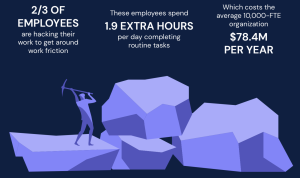It might well be the end of the year, but there’s just enough time to sneak in a another new workplace trend to try and get your head around ready for 2024 – and it’s called “workplace friction.”
According to many of the business leaders that suffer it, workplace friction is anything that makes jobs harder, less productive, less enjoyable.
Forbes offered up a simpler definition back in 2018 – saying that friction is simply an action that’s done in opposition to, or that challenges, the status quo.
Generally speaking, workplace friction isn’t something companies really want too much of. Yes. occasionally, workplace friction is a good thing. Take, for example, when it surfaces as healthy competition between teams – where colleagues debate how best to solve a customer’s problem.
A decision to turn down a new idea because it’s not driving towards the overall goal is also healthy workplace or “good” friction that helps the wider organization.
However, friction that comes from a negative place and isn’t properly managed typically leads to conflict — and that’s when it becomes a real business problem.
The “massive gap” in workplace perceptions
Because friction is now a ‘thing,’ it won’t surprise you to hear that there are firms springing up all the time to attempt to deal with it.
One company in particular is called Fount – a business that describes itself as “a platform that helps companies identify and reduce work friction.”
Based in Washington, D.C. — a city that pretty much personifies the concept of workplace friction — Fount has just released some interesting research from its 2023 Work Friction Survey.
The major findings from the survey shouldn’t be entirely unexpected, because they clearly show “a massive gap between how business leaders and employees perceive work friction.”
For instance, while nearly half of employees said that workplace friction has gotten worse, this is wildly at odds with three-quarters of business leaders who believe “that work friction had not changed or had even improved.”
That’s a pretty big gap, but not terribly surprising.
It’s also not a shock that Fount’s research also found that:
- Work friction is a likely contributor to absenteeism and attrition
According to Fount: Nine out of ten employees (a whopping 95% in fact), said that “work friction makes them feel bad about their job. Meanwhile, 37% of employees say work friction makes them feel so bad they want to quit or take days off. In short, work friction likely plays “a significant role in absenteeism and attrition.”
- Work friction is perceived to stifle personal productivity and quality customer service
According to Fount: Some 68% of employees say that “work friction has a negative impact on their personal productivity and their ability to provide strong customer service.”
Fount’s’s 2023 Work Friction survey suggests that the main problem with workplace friction is that it’s likely to be getting worse rather than better at most companies.
The analysis shows that, “although 91% of leader respondents said work friction reduction is a priority for their organizations, only 42% have so far taken action to reduce it, and less than 20% are tackling work friction in employees’ day-to-day work, where it most often occurs.”
Research that “clearly indicates a stark divide”
Gartner has also been tracking this issue for the past few years, and its work finds employees waste two hours per day trying to work around workplace friction.
That may not sound a lot, but for a Fortune 1000 company with 10,000 employees, that amounts to 3.1 million wasted hours per year, with an annual loss of $78.4 million (see below):

Christophe Martel, the Co-founder and CEO of Fount, offered this insight:
“While most leaders believe they are well-informed about the work friction their employees experience, this research clearly indicates a stark divide.”
He adds:
“Despite record investment in learning and development, staffing, and technology to make work better, employee quit rates have more than doubled in the last decade…”
Dealing with friction

According to Martel work friction symptoms are usually very obviously apparent – showing up in metrics like absenteeism and low productivity.
Less comforting though, is the fact that merely treating the symptoms of friction is unlikely to really solve anything. Martel argues doing this means problems will simply “persist or could even get more complicated.”
A concept worth a closer look
One more thing:
Managing workplace friction is a relatively new concept.
It wasn’t all that long ago when the Harvard Business Review was writing about The Darwinian Workplace, a “winners-take-all” approach where “better workers take more assignments, and the others get what remains.” It suggested that: “Over time, it may induce low performers to quit, leading to a higher-performing workforce and a constantly rising bar.”
This “higher-performing workforce” is a worthwhile goal, but in some organizations it has fostered a lot of gladiator-like conduct where employees were pitted against each other to see who would succeed and who would be discarded.
The end result did drive more productivity, but in many cases, a lot of good people got tossed because they didn’t have the mental makeup to play the gladiator games.
But the notion that reducing workforce friction on the job can make for a more productive workplace is a good one, and a step in the right direction away from The Darwinian Workplace to a management system based on reducing friction to get the very best out of people.
I’m not sure if workplace platforms based on reducing friction will be successful, but anything that helps in achieving that goal are worth a closer look.
About the 2023 Work Friction Survey:
Fount Global Inc.’s 2023 Work Friction Surveys were fielded in August 2023 in collaboration with our panel survey partner, RepData. A total of 706 panelists were sourced from across North America, Europe, and ANZ using multimodal collection: 506 employees completed an 11-question survey online; 200 HR, business, and C-suite leaders completed a 4-question survey in telephone interviews. Both surveys included closed- and open-ended questions; the latter were coded to generate quantifiable results for comparison with closed-ended responses.
